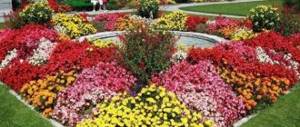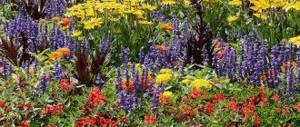Growing decorative flowers is usually associated with a country plot or dacha, since it is there that you can plant beautiful flower beds and flower beds as you please and realize your flower growing fantasies with almost no restrictions.
But flower lovers can afford to create a mini-flower garden in an urban environment - on the balcony of their apartment. Beautiful flowers can grow and bloom there just as well as in a suburban area.
To do this, you just need to competently approach the choice of plants and care for them.
We’ll tell you about the important points when creating a home flower garden with your own hands: which flowers for the balcony are best suited for your specific situation, how to care for them and what else you can plant, we’ll share tips on design and arrangement.
To a greater extent, the choice of plants will depend on the location of the loggia relative to the cardinal directions, and on the degree of illumination.
There may also be a choice: annuals or perennials? The latter require long-term systematic care and, accordingly, a lot of patience from the gardener, so let's talk about annuals.
Names and photos of flowers suitable for a south balcony
Most garden flowers are very heat-loving and creating a flower arrangement on a south-facing balcony is not at all difficult.
Of course, you might think that the more sun the better.
But you need to take into account several serious points regarding the effect of direct sunlight on flowers:
- The scorching rays of the sun cause burns to tender leaves.
- On the south side, the summer can be swelteringly hot. In such conditions, flowers require frequent watering and regular spraying.
When choosing a plant with this orientation, you need to start from the following characteristics of the species and varieties: high drought resistance, good ability to tolerate sunlight, light-loving.
Pelargonium (Pelargōnium)
Very similar to geranium, but they are different plants. Tolerates direct sunlight well. Zonal (Pelargonium x hortorum, Zonal pelargoniums) and ivy-leaved (Ivy-Leaved Pelargoniums) varieties are most resistant to abundant sunlight.
Zonal pelargoniums have leaves with a characteristic zonal pattern that differs in color. The flowers are collected in large umbrella-shaped inflorescences, which can be laid along the entire length of the shoot, resulting in long-term flowering. Given sufficient heat and light, such varieties can bloom all year round, starting in March.
Photo:
Green Color
Divas Blueberry
Night Scarlet
Mimi (Dwarf)
Patricia Andrea
Ivy-leaved pelargoniums are distinguished by long, thin stems and tough, ivy-like leaves. The leaves are covered with a thick cuticle, which helps reduce moisture loss during drought.
Photo:
Milfield Rose
Falko Toskana
Pac Sally
With an abundance of light, pelargonium will even intensify its flowering. It can also go without watering for a long time. True, royal pelargonium is an exception of its kind and needs to be shaded during the hottest midday hours.
Calendula, marigold (Calendula officinalis)
In addition to the fact that calendula is light-loving and drought-resistant, it is also one of the plants that blooms all summer. Flowering period: from June to September. For long-term flowering, you need to remove faded inflorescences.
For loggias, the low-growing variety Calendula Officinalis Fiesta Gitana, which has various types of color, is most suitable. It grows very well from seeds.
Calendula Officinalis Fiesta Gitana
Petunia
Decorating a balcony with these bright light-loving flowers is one of the most popular and proven ideas today. As for drought resistance, in hot summer conditions on the south side they require moist soil and frequent watering (about 2 times a day!). To reduce the need for frequent watering, you need to select deep boxes for petunias and mix hydrogel into the soil.
Petunias
Purslane (Portulaca)
Purslane blooms abundantly in the south.
It tolerates heat and direct sunlight well, and does not require frequent watering, as it is a succulent plant (with stems and leaves capable of accumulating moisture). Purslane flowers have a wide variety of bright, rich tones, which will allow you to create a variety of color compositions.
The most used species for growing on loggias are: garden purslane, double purslane, grandiflora purslane.
Purslane grandiflora
Nasturtium
Flowering period: from July to September. Grow by seeds immediately in a permanent place. Nasturtium is an unpretentious flower; it almost always grows from seeds.
Nasturtium
Interestingly, the flowers of different varieties are radically different from each other. There are tall climbing vines that can be used to decorate walls, hanging flowers for balconies and window boxes (for example, nasturtium peregrinum, reaching a length of 3 m), as well as bush-like dwarf varieties.
Also suitable for the sunny side are: calibrachoa, morning glory, sweet peas, kobea, godetia, aster, canna, gatsania, mignonette, sweet tobacco, zinnia, phlox, dahlias, sedums, all succulents and cacti.
Eastern and western location - what to plant?
Eastern orientation is the most successful option for growing flowers.
Soft, harmonious lighting is suitable for the vast majority of plants. Hydrangeas are especially recommended for such rooms. Hydrangea flowers fit perfectly into Provence and vintage style. They require moderate lighting, and watering should be approached very carefully if you want to watch them bloom all summer.
Also perfect here are daisies, heather of various types and varieties, calendula and lobelia.
If you have a loggia in the west, this is also a very good option. The sun here comes in the afternoon, and is no longer as scorching as during the day. Therefore, plants that love partial shade are well suited here.
A wonderful option for this arrangement is verbena, which has voluminous inflorescences with large flowers. It has a large assortment and a wide color spectrum. But in order for verbena to bloom for a long time, you will need to water it daily and loosen the soil.
A more unpretentious option for the western side is sedium. It blooms profusely until mid-autumn. Climbing plants such as morning glory, grapes, and climbing roses will also feel good here.
Beginner gardeners often wonder if it is really possible to plant grapes on the balcony and expect them to bear fruit? Yes! To do this, first of all, you need to choose grape seeds of a variety that will not be afraid of the weather conditions of your region.
Varieties that are not afraid of frost and are resistant to other features of the Russian climate: Laura, Northern and Taiga.
What to grow on the north side?
What can be planted on the northern balcony? Typically, landscaping in this location is not an easy task for gardeners, since the plants here bloom poorly or do not bloom at all.
Therefore, the assortment in this case should be selected primarily according to the criterion of shade tolerance.
Fuchsia
To bloom profusely, fuchsia does not require abundant lighting; it only needs light from the north side.
Fuchsia does not like open sun and heat, but it really needs abundant regular watering, otherwise it will die.
Begonia
Begonia grows well in semi-shaded and shady areas, requires fertile acidic soil and needs intensive watering and fertilizing.
Torenia
Torenia loves bright, but diffused light, so the balcony boxes would be the place for her. Requires regular watering. The soil for fermentation must be kept moist at all times.
A balcony with a northern orientation is also suitable for growing pansies, balsam, violas, ivy, mignonette, nasturtium, cyclamen, and various bulbous flowers (such as tulips, daffodils). All these flowers do not like direct sunlight and high temperatures.
Balcony on the shady side
Balconies on the shady side of the building suggest planting flowers that do not suffer from a long-term lack of sunlight. Such balconies require particularly careful selection of plants.
In the absence of sunlight for a long time, many light-loving plants look lethargic, stretch out, bloom weakly, or do not bloom at all.
The following plants are suitable for a shaded balcony:
- Fuchsia - this flower is not recommended to be exposed to direct sunlight, so a shaded balcony is an ideal solution for it. Fuchsia grows in lush bushes; it is recommended to keep it at a temperature of 20-25 degrees. At the same time, abundant and regular watering is a prerequisite for productive growth. The soil for fuchsia should not dry out.
If you skip several waterings and dry out the fuchsia, it will die.
- Mimulus - this plant is distinguished by its variegated color and elongated flowers. Direct rays of the sun are contraindicated for this flower, so it will feel quite comfortable on a dark balcony. This flower grows well only in moist soil, therefore special attention should be paid to timely watering.
- Calceolaria - this flower does not tolerate high temperatures, excess sunlight and dryness. The best solution would be to place such a plant in light partial shade. You also need to make sure that the area allocated for the calceolaria is well ventilated. This flower needs to be watered regularly. However, when watering, you need to make sure that water does not get on the leaves and stem, as the plant can quickly begin to rot. In our country, this flower is not yet particularly popular, so a balcony filled with calceolaria will look quite exotic.
- Torenia - the flowers of this low-growing plant resemble gloxinia bells, however, they are much smaller and usually bloom in large groups. This flower needs bright but diffused light, therefore a shaded balcony is the best option. It is also necessary to ensure that the plant is regularly watered - the soil in the pot should not be dry.
Ampelous plants
Hanging flowers are usually called decorative flowers with flexible long stems that curl upward or spread along the ground.
For planting such plants, it is best to use plastic hanging pots. Although, in this case, it is also appropriate to use various baskets, pots and flowerpots. If you plan to plant a flower in a pot made of metal rods, then you need to put foam or coconut fiber inside.
In this case, the seedlings should be planted in a circle without breaking the symmetry. Seedlings need to be protected from excess sunlight. When the flowers grow a little, you can start using fertilizer.
In especially hot weather, such plants need to be watered at least once a day and sprayed.
Today there are many different options for hanging flowers. The appropriate variety can be selected for any type of balconies.
Under no circumstances should shade- and light-loving or drought-resistant and moisture-loving flowers be planted together.
The most popular varieties of hanging plants today are the following:
- Begonia is a rather whimsical plant. It requires plenty of light and frequent watering.
- Nasturtium - this plant also loves an abundance of light, but does not require such careful care. It is not recommended to water nasturtium too much; however, the soil must be periodically fertilized with various phosphorus fertilizers.
- Lobelias are a universal ampelous flower. It can be planted both in the sun and in the shade. For active growth it needs moisture and regular fertilization. There are both annual and perennial varieties. If you plant perennial flowers, they must be kept warm throughout the winter.
Houseplants
To “green” your balcony, it is not at all necessary to plant special balcony flowers. In the warm season, most existing indoor plants can be safely transferred to a balcony or loggia. However, it must be taken into account that the climate in the room and outside it varies greatly, so the flowers must be gradually accustomed to unusual conditions.
You can take flowers out onto the open balcony only if the air temperature outside the window is set at 15 degrees in the morning.
In the first days, plants should not be left on the balcony around the clock. They can be taken out to the balcony in the morning and brought back in the afternoon.
In spring and autumn, it is not advisable to leave indoor flowers on the balcony overnight. Spring nights can be quite cold, and many plants cannot tolerate sudden changes in temperature.
Starting with a couple of hours a day, the time a flower stays on the balcony can be increased to 24 hours.
But this is only provided that the difference between day and night temperatures is minimal.
If your balcony is located on the sunny side, then you need to provide for the possibility of shading indoor plants. For this you can use curtains, curtains or blinds. It is necessary to return indoor flowers back to the apartment depending on the weather. It is unlikely that it will be possible to name the exact period. It is best to bring plants indoors when the nighttime temperature drops below 15 degrees.
Another sign of the need to return flowers indoors is prolonged rainfall. After returning the indoor plant to the apartment, be sure to treat the soil with a nutrient composition.
Mosaic Kerama Marazzi.
Read how to remove liquid wallpaper from a wall here.
Types of marble: https://trendsdesign.ru/materialy/mramor/mramor-dorogoj-material-dlya-professionalnoj-otdelki.html
Arrangement of indoor plants
Arranging indoor plants on the balcony seems much simpler than gardening - it would seem just to move the plants in pots and arrange them in a composition. But it is obvious that not all house flowers will find the new environment suitable for life. It may be too cold for someone on an open balcony, but too hot on a closed one (due to direct sunlight).
When placing indoor flowers outside, you need to take into account that night temperatures in spring and early summer are much lower than daytime temperatures.
Many indoor flowers can easily tolerate temperature fluctuations within 15-20 degrees, but it should not fall below 12-15. It is especially difficult for plants if a cold snap occurs after watering (or rain) - wet roots after a “temperature shock” can rot.
The question often arises: when can you place flowers on a glass or open balcony?
If flowers can be displayed on glazed (but not insulated) loggias at the end of April, then on open loggias - only by the end of May.
There are indoor flowers for which life in the open air is in principle impossible. Of course, a lot depends on the climate, but at least these plants are best left at home: cacti, violets, tropical flowers with special humidity requirements - Dieffenbachia, philodendron.
Composition for a balcony from light-loving crops, video:
Drawer selection
When it comes to choosing flower boxes, today the market offers a huge assortment. To achieve a harmonious combination in choosing a tone for flower containers, you need to take into account the general style of the balcony, as well as the facade of the house.
It can be a plastic, wooden or even a stone box (these are also available on the market now).
The box can be hanging with holders or regular, placed on a stand. Now you can also purchase a “house” for flowers with a special form of attachment to the balcony railing as in the photo.
In order for your flowers to feel good, the general mandatory requirements for boxes are as follows:
- Flower boxes must be durable and weather resistant. Typically, most modern plastic boxes meet these requirements (although this is difficult to determine when purchasing, since manufacturers of flower containers are not required to label their products according to these indicators).
- The bottom of the box should have drainage holes every 20 cm with a diameter of about 1 cm.
- When watering, water should not flow onto walls, floors and sidewalks. To do this, provide pallets with sides about 5 cm high.
You can buy flower boxes for your balcony at any garden store quite cheaply. There is a large selection in stores such as Obi, Leroy Merlin, as well as on Internet portals.
The price ranges from 150 to 2000 rubles depending on the size and material of the box.
Balcony garden all year round
In the spring . In order for your garden to begin to delight with the beauty of flowers in the spring, from mid-April you should plant seedlings of daisies, begonias and violas. On closed, warm balconies you can plant bulbous crocuses, daffodils and tulips.
In summer . Flowers such as ficus, azalea, pomegranate, aloe, cyclamen, crassula, hydrangea, agave and the like will feel great in the summer air.
Ever-flowering begonia, pelargonium, and coleus must be cut from cuttings in winter and planted again in the loggia area in warm periods.
DIY flower garden on the balcony
But for tropical and subtropical plants it is difficult to tolerate open soil; it is better to plant them in a glassed room with humid air. For example, royal begonia, philodendron, sansevieria and dieffenbachia.
In autumn . To make your beautiful garden fragrant in the autumn, you can plant, for example, tuberous begonia and sedum, asters, kobeya, petunia, gatsania, as well as garden asters and chrysanthemums.
If the balcony area or loggia is glazed, then the plants will bloom for a long time, and their conditions will become much better.
For example, during a hot period, using roller blinds or blinds can cover the flowers on the balcony from direct sunlight, and also protect them from overheating and drying out.
Home garden
Perhaps, in addition to beautiful flowers that will please the eye, you will want to have crops that are useful for something else, for example, tasty fruits. Ornamental plants in combination with fruits and vegetables can create a special unique composition.
It is now possible to create a small vegetable garden at home even in areas with a harsh climate thanks to the work of breeders who have created zoned varieties. For a hot indoor space, growing a vegetable garden is best suited, since it is a kind of year-round greenhouse.
Planting tomatoes
Perhaps the most popular and sought-after vegetable for planting on loggias among Russians is tomatoes. In an apartment garden, these can be both varieties with large fruits and small ones, for example, cherry tomatoes.
You can grow tomatoes either from seeds or seedlings, but for cold climates it is still better to go with the second option.
It is better to plant tomato seedlings on closed balconies in early May, and on open ones it is better to start growing them in early summer.
It is necessary to arrange the sprouts in such a way that direct sunlight does not fall on the leaves, and you also need to take care that there is no stagnation of water in the ground.
To increase the yield, it is necessary to pinch off all the branches and leaves that are higher than the fifth or sixth flower tassel. It is advisable to plant tall tomatoes at a distance of about 40 centimeters from each other and be sure to tie them to supports.
Planting cucumbers
It is very important to choose self-pollinating (not requiring pollination by bees) varieties of cucumbers for your garden.
These can be the following varieties: Gribovsky, Dubrovsky, Kurazh, Parus, Kukaracha, Stresa. When growing, it is necessary to take proper care of watering cucumbers - the soil should always be moist. It is necessary to periodically remove the antennae (at least once a week).
To increase productivity, the tops of cucumbers need to be pinched and formed into one stem. Cucumbers also need supports; they can be decorated with a beautiful trellis, from which cucumber vines will create a beautiful green wall, which can complement your flower arrangement well.
Strawberry
Everyone's favorite strawberry is suitable for growing in almost any conditions. But a good harvest can be obtained with proper planting, proper care, watering and pollination.
On balconies, strawberries are grown in a regular rectangular container, as well as in hanging pots or a shelf.
When purchasing strawberry seedlings, you need to find out the resistance of the variety to diseases and the fruiting period (it is better to purchase both early and late varieties, which will ensure continuous harvesting of berries).
The Albion strawberry variety is distinguished by repeated fruiting. If you need a frost-resistant variety, then this is the Temptation strawberry.
What can you plant from greenery?
In addition to vegetables and berries, of course, you can plant healthy greens. For example, herbs that you can use in your kitchen: basil, rosemary, mint, thyme and sage.
They are sown directly into the ground. You can also grow different varieties of green lettuce. You can buy seeds in almost any specialized online store.
Caring for flowers on the balcony
Growing flowers on the balcony, photos of which are so pleasing to the eye, requires certain knowledge. Selecting the best varieties based on lighting is not enough.
Multi-tier flower racks
There are two ways to grow flowers on the balcony in boxes. In the first case, flowers are planted in one row, alternating varieties with different colors. In the second, upright varieties are combined, they should be planted in the background, and hanging varieties, they should be placed in the foreground.
Boxes in the floral decor of a balcony (loggia) Planted plants must be properly cared for. The following rules must be followed:
- The pot should be large enough so that the earthen ball does not dry out too quickly. It is also important that the pot does not overheat. In such cases, there is a risk of peripheral roots dying off, as a result of which the plant will not receive the required amount of nutrition, which will affect nutrition. The best option is wooden boxes with holes for drainage.
- Garden soil is not the best solution for loggias. It can be infested with pests, and after a while it turns into a solid lump, which makes watering difficult. It is worth choosing store-bought soil mixtures.
- Watering needs to be given special attention. The soil should not dry out; it is recommended to check this with your finger. In summer, on the hottest days, it is allowed to water the plants twice a day. It is convenient to use devices for drip irrigation. They can be purchased in specialized stores or made yourself from a plastic bottle.
- You can't do without regular feeding. Potted flowers need an additional source of nutrition. For most of them, it is enough to carry out the procedure twice a month.
- It is necessary to carefully inspect the plantings from time to time so as not to miss the appearance of any disease or pests. If unpleasant signs appear, you will have to use appropriate remedies.
Types of flowerpots and tiered arrangement
Hanging decor ideas
Landscaping ideas
Vertical placement (options)
If the balcony is located on the side where the sun's rays shine almost constantly, then it is better to place light-colored pots. They heat up less, making it easier to care for plants.
You can grow a wide variety of flowers on your balcony. The abundance of colors and pleasant aroma will make this corner of the apartment surprisingly cozy. You just need to choose the right varieties and spend some time caring for them.
Previous entry Work plan for thermal insulation of a balcony room from the inside: high-quality insulation of the loggia
Next entry Petunia on the balcony: secrets of growing and care
Balconies with strong winds
To ensure the stability of flower plantings and to avoid falling, it is recommended to place heavy stones at the bottom of containers/planting boxes; you can also fasten the boxes together and tie them to balcony railings.
If your balcony is very windy, we recommend choosing plants with dense, fleshy leaves and flexible shoots, such as ivy, calendula, begonia, gazania and daisies.
You also need to take into account that the higher the floor, the stronger the wind. Starting somewhere from the 7th floor, it is better not to keep large plants. In this case, it is better to plant begonia, marigolds or ageratum.
Flower decoration - tips
Some interesting ideas so that your flower corner can become a place that truly pleases the soul:
- One of the frequent and very effective traditional techniques for balcony design is the use of hanging flowers in hanging pots and cache-pots. (Tramping are ornamental flowering plants with a long flexible stem, usually unable to support itself, which needs support.)
- Instead of using a regular concrete floor or other material on your balcony slab, consider using an artificial green carpet or wood flooring. This will create a natural atmosphere, close to a park or garden.
- Hanging flower boxes can be installed on the outside of the fence to create more space.
- Use trellis structures for weaving and climbing plants. You can make them yourself from wooden slats or bent steel rods. This will create a special atmosphere.
- If possible, place flower shelves on the wall of your balcony to stack pots on. This will create a lot of open space and also, if you are a fan of "regular styles", will create an organized flower arrangement.
- You can also decorate your balcony garden with several design details that complement the overall style, such as figurines, lanterns, candle holders or colorful wall pictures. You can add other garden accessories to suit your small space.
- One of the interesting solutions for decorating a balcony is the use of forged stands and brackets for flower pots or containers.
The simplest methods of “green” balcony design
To decorate a balcony, it is not advisable to buy everything; it is better to use one interesting idea or general concept. Plant varieties are selected according to the principle of compliance with the design concept.
If you organize a gym or mini-hall on an insulated loggia, then there is no place for large plants. They will interfere with your training. It is better to place a collection of succulents in the free corners. These are compact plants with fleshy leaves that retain moisture, like cacti. It is cacti and other thorny plants that would be inappropriate here - awkward movement, and a lot of needles in the body. Nothing will happen to lithops and succulents, even if you hit them with a weight, they easily reproduce vegetatively. The plants are undemanding in care and are rarely watered, which is convenient for those people who forget about them.
Balcony with flowers
Flowers on the balcony
Balcony plants will help emphasize the Japanese style in interior design. This is a collection of bonsai, a compact sakura tree in a tub and 2-3 junipers for a “rock garden”, skillfully laid by craftsmen around a small homemade pond, as in the photo. A Japanese-style curtain with hieroglyphs will complement the overall picture.
There are many other ways to decorate a balcony with flowers. For example, to imitate a corner of a certain climate zone or a recognizable corner of the planet. Or you can decorate several square meters as a terrace of a Parisian courtyard, using adhesive film for glass with views of Paris. Inside, the balcony is designed as a place for romantic dates with indoor roses. Another option is the same collectible cacti for Mexican-style apartment design.
Balcony design with flowers
Flowers in the interior of the balcony
An unexpected play of color is a good design technique. Today, dark purple, black and green colors (of different types) are in fashion against a background of lush greenery and white plastic containers. Extravagant decoration of the balcony with flowers is appropriate in an apartment with elegant white decor in any modern style.
Ivy and wild grapes are ideal plants for landscaping and shading an apartment on the 1st floor on the south side of the house. You just have to plant them under the balcony in the yard. There are very beautiful varieties that would be quite appropriate for decorating a corner of the house in the English style. The apartment will have an aristocratic interior and a courtyard covered with ivy, as in literary works. Just don’t forget to cut off several cuttings of ivy for the winter and place them in a vase to receive cuttings. Ivy dies during severe frosts, although it is a persistent perennial.
Balcony landscaping often suffers because of pets who like to rummage in the soil with plants and nibble on fresh herbs (due to a lack of vitamins). You shouldn’t punish them for this - organize a green “lawn” in a small box. The corner where they can misbehave with impunity should be at the bottom. It is better to plant flowers in hanging flower pots, forming a kind of arch on the front side of the balcony. Plants can be hung in any order, the main thing is that they are inaccessible to the cat.
Various flowers on the balcony
Balcony with flowers
Beautiful flowers on the balcony
Experts have developed an all-season way to decorate a balcony with flowers. This is when different flowers delight with their fragrance all year round. For example, crocuses and primroses are replaced by balcony forms of tulips and daffodils, and then “flowerbed” annuals bloom wildly. In autumn they are replaced by asters, dahlias and chrysanthemums, and in winter dwarf needles with small cones turn green.
Do not forget about adequate lighting, watering and fertilizing of plants. Then, with any balcony design, they will delight the eye with their healthy appearance, lush greenery and charming flowers.











